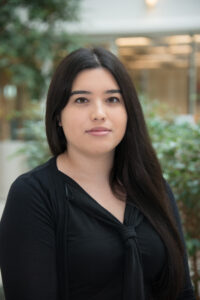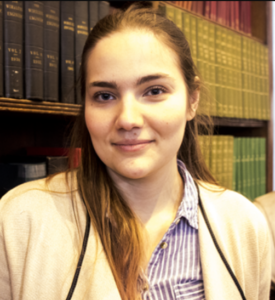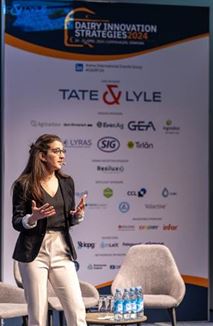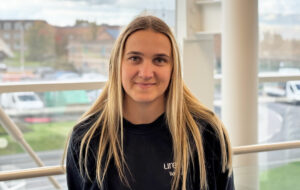Are you curious about a career in STEM (Science, Technology, Engineering, and Maths) but worried it’s not right for you? Careers in STEM are filled with exciting opportunities that go far beyond lab coats and complex calculations, yet often misconceptions about a career in STEM prevent students from following what can be an accessible and rewarding path.
To mark National Careers Week and British Science week, corporate partners from across the Science Museum Group tell us what working in STEM is really like and help us breakdown some common misconceptions about STEM careers.
Susan Cammiade, Surveillance Product Owner, BNP Paribas

1. What company or organisation do you work for, and how does it contribute to the STEM field?
I work for BNP Paribas bank. Banking is now a tech business and STEM is in our DNA: digital transformation, fintech partnerships, data science, cybersecurity and more! Via DEI initiatives, we collaborate with schools and universities, promoting STEM education and driving innovation and sustainability.
2. Can you describe your role and the kind of projects you work on?
As a Product Owner, I help make sure our products meet the needs of our customers and users. I work with many teams and partners to make sure we’re all on the same page and align with business goals. My job is to make informed decisions based on data to improve our products, spot potential problems, and ensure our projects align with what our company wants to achieve. The projects vary widely, ranging from developing software applications to driving process improvement and leading digital transformation efforts such as the use of Artificial Intelligence & Large Language Models.
3. What is a common myth or misconception about your field that you’d like to correct?
It’s not all about sitting at a desk and designing things on a computer; in reality it’s a hands-on role that requires collaboration and problem-solving. No two days are the same!
4. Looking back, what is something you wish you had known before starting your career in STEM?
Managing imposter syndrome and self-doubt are common experiences for many people in STEM; learning how to manage this earlier on would have saved a lot of stress and anxiety.
5. What is the best piece of advice you would give to someone who wants to work in STEM?
Be curious and keep learning – don’t be afraid to ask questions! A mentor can provide invaluable support and feedback.
Dr Sophie Penman, Clinical Development Director, GSK

1. What company or organisation do you work for, and how does it contribute to the STEM field?
I work for the Pharmaceutical Company GSK. We are a healthcare company that develop medicines and vaccines.
2. Can you describe your role and the kind of projects you work on?
I am the Clinical Scientific Lead for three medicines in our tuberculosis portfolio. It is my responsibility to design clinical trials that will allow us to assess if our medicines are working. Once we get the data from our trials, I lead the clinical team to review and analyse the data and build a strategy to get our medicines available to patients.
3. What is a common myth or misconception about your field that you’d like to correct?
When people hear that you’re a scientist, they automatically think you work in a lab whereas my role is office-based. There is a plethora of scientific roles that do not require you to work in a lab.
4. Looking back, what is something you wish you had known before starting your career in STEM?
Negative data is not bad. I spent a lot of my PhD thinking that negative results meant I had failed however, negative data is still a result and has provided an answer to a previously unanswered question.
5. What is the best piece of advice you would give to someone who wants to work in STEM?
Don’t under-estimate the power of networking. Through networking I was able to build relationships with professionals working in the pharmaceutical industry who were able to mentor and guide me. If it hadn’t been for those people within my network, I wouldn’t be working at GSK today!
Deborah Ferreira, Software Engineering Manager – Natural Language Processing, MathWorks

1. What company or organisation do you work for, and how does it contribute to the STEM field?
I work at MathWorks, the company behind MATLAB and Simulink. Our software is used in a wide range of fields, from AI and robotics to aerospace and healthcare. It is exciting to be part of a company that helps drive innovation.
2. Can you describe your role and the kind of projects you work on?
As a manager and engineer at MathWorks, working on integrating GenAI and large language models into MATLAB. Currently, there is a lot of focus on AI-assisted programming, helping users leverage AI to write and improve their code. This includes working with AI models, processing data, training and fine-tuning models, and making MATLAB coding more intuitive and efficient.
3. What is a common myth or misconception about your field that you’d like to correct?
A common misconception about my field is that AI will render programming skills obsolete. However, having hands-on experience with these tools, I recognize their current limitations and the potential for growth. AI serves as a powerful ally in enhancing productivity, and the future holds exciting possibilities for this technology.
4. Looking back, what is something you wish you had known before starting your career in STEM?
Early in my career, I focused a lot on the technical side and did not realize how important it is to communicate ideas effectively. Writing code is only a small part of the job. Being able to share your work and collaborate with others is just as important.
5. What is the best piece of advice you would give to someone who wants to work in STEM?
STEM is always evolving, so adaptability is key. Trust yourself and trust the process. Keep pushing forward, stay open to new ideas, and embrace the learning curve.
Mark Stevenson, Senior Vice President – EMEA Deputy CTO, Northern Trust

1. What company or organisation do you work for, and how does it contribute to the STEM field?
I work for leading global financial services company, Northern Trust. At Northern Trust, we recognize the critical importance of STEM in shaping the future of finance and in our talent acquisition. We engage in STEM education initiatives, such as the Science Museum STEM skills fair and we host workshops and seminars to inspire the next generation of STEM professionals. We are committed to sustainable practices and ethical use of technology. By integrating STEM principles into our corporate responsibility efforts, we aim to create a positive impact on communities, society and the environment.
2. Can you describe your role and the kind of projects you work on?
I am the Deputy Chief Technology Officer (CTO) for Europe, the Middle East and Africa (EMEA) at Northern Trust. I provide leadership and guidance to the planning, organization, direction and control of technology within the EMEA region and drive global best practice.
3. What is a common myth or misconception about your field that you’d like to correct?
One common myth about the financial services and technology sector is that it is a purely “numbers-driven” industry. This misconception often leads people to believe that working in finance and technology involves solely crunching numbers.
In reality, our industry thrives on creativity and finding innovative solutions to complex problems. Whether it’s developing new financial products, optimizing algorithms for better performance, or enhancing user experiences, creativity is at the core of what we do.
4. Looking back, what is something you wish you had known before starting your career in STEM?
The importance of interdisciplinary skills and the value of continuous learning. When I first entered the field, I believed that deep expertise in one specific area would be the key to success. While having a strong foundation in a particular discipline is important, the ability to adapt, learn new skills, and collaborate across different teams and domains is equally crucial.
5. What is the best piece of advice you would give to someone who wants to work in STEM?
The best piece of advice I would give to someone aspiring to work in STEM is to cultivate a mindset of curiosity, resilience, and collaboration. Treat every day as a learning opportunity.
Maisie Irvine, Graduate Electrical & Electronics Engineer, Siemens

1. What company or organisation do you work for, and how does it contribute to the STEM field?
I work at Siemens, the global technology company focussing digitalisation and automation. We use a combination of software and hardware to create sustainable solutions worldwide.
2. Can you describe your role and the kind of projects you work on?
I am a Graduate Electrical and Electronic Engineer. As part of my graduate scheme, I must do four different six-month long placements, giving me the opportunity to explore completely different corners of the company. Currently, I am working on a project with universities nationwide to help integrate Senseye, our predictive maintenance system, into their curriculum.
3. What is a common myth or misconception about your field that you’d like to correct?
I constantly hear the myth that technical skills are more important than soft skills in engineering. While technical skills are of course important, successful projects at work require strong communication, critical thinking, and enthusiasm.
4. Looking back, what is something you wish you had known before starting your career in STEM?
I wish I had known that it’s okay not to know everything right now, as being open to asking questions and asking for help, leads to a better result. The technology world is constantly changing and the only way to keep up is to embrace continuous learning, no matter how far into your career you are.
5. What is the best piece of advice you would give to someone who wants to work in STEM?
For anyone looking to get into STEM, I would say that nobody has everything figured out! Everyone gets imposter syndrome and it’s normal to doubt yourself, but you deserve to be where you are just as much as anyone else around you.
Marietta Sayegh, European Business Partner (Nutrition), Tate & Lyle PLC

1. What company or organisation do you work for, and how does it contribute to the STEM field?
I’ve been working at Tate & Lyle PLC, a leading global food and drink ingredient company, for two and a half years. We use food science, nutrition research, and ingredient innovation to help food and drink producers worldwide to make healthier products.
2. Can you describe your role and the kind of projects you work on?
I focus on communicating our scientific research externally, ensuring that it reaches the right audiences, because research isn’t complete until it is shared and understood! Recently, I’ve spoken to UK MPs about the importance of dietary fibre for public health, and helped food producers to understand how to use fibre to replace sugar in their products.
3. What is a common myth or misconception about your field that you’d like to correct?
I didn’t think a nutritionist could hold much sway within a business, but I see within Tate & Lyle and our customers that nutritionists are listened to and empowered to drive change.
4. Looking back, what is something you wish you had known before starting your career in STEM?
Your career path is not set in stone. After completing a PhD and postdoc, I believed academia was my only option, but I quickly realised there were many exciting opportunities beyond academia that aligned with my skills and interests.
5. What is the best piece of advice you would give to someone who wants to work in STEM?
Resilience is important, particularly in scientific research as things don’t always go to plan. Also, your voice matters! Networking, sharing your ideas, asking questions, and engaging in discussions help build confidence and allow others to see your value. Finding your unique strengths starts with making yourself heard.
Tia, Laboratory Technician Apprentice, Urenco

1. What company or organisation do you work for, and how does it contribute to the STEM field?
I work for Urenco where we use centrifuge technology to enrich uranium which is later converted into nuclear energy. STEM can be seen across many areas within Urenco, for example, we have people working as laboratory analysts, mechanical and electrical engineers, and IT service engineers. But there are also lots of more traditional roles available to people wanting to work in an exciting STEM industry where we make a sustainable difference.
2. Can you describe your role and the kind of projects you work on?
I am currently a Laboratory Apprentice working in various areas inside our building. My role consists of preparing and analysing a wide range of samples from grasses and soils, to radioactive materials. I have also been involved when the team is developing methods and suggesting improvements.
3. What is a common myth or misconception about your field that you’d like to correct?
A common misconception when working in STEM is that there is a clear division between the new employees and those who have worked in industry for an extensive period of time. In my experience I found that all of my colleagues made an extra effort to make me feel part of the team from the moment I started onsite. Having a diverse workforce allows us to learn from one another and in turn develop our knowledge. I often provide the team with a new, youthful perspective whilst others share their skills and experiences.
4. Looking back, what is something you wish you had known before starting your career in STEM?
Something I wish I had known before starting my career in STEM is that many roles offer work experience to those in high school, and placements to those in university. This prior experience before working in your chosen field can be a great way to adapt to the STEM environment.
5. What is the best piece of advice you would give to someone who wants to work in STEM?
Jobs in STEM are available to people of all ages and backgrounds. Whether you have years of experience or are just leaving high school, there is truly something for everyone. Apprenticeships and work placements can be a great opportunity to develop and expand on your knowledge.
As we’ve seen from the individuals featured in this blog, working in STEM careers is about problem solving, being creative and collaborating with others. If you stay curious, keep learning seek out mentors during your career, the possibilities in STEM can be endless!
Technicians: The David Sainsbury Gallery at the Science Museum explores STEM careers further and recreates the workplaces of technicians across multiple sectors – health science, creative arts, manufacturing and renewable energy. The gallery features as part of National Careers Week’s virtual Careers Fair, where you can find out more about technical roles and the different routes into them.
You can learn more about how corporate partners contribute to the Science Museum Group’s mission to Inspire Futures on our website.